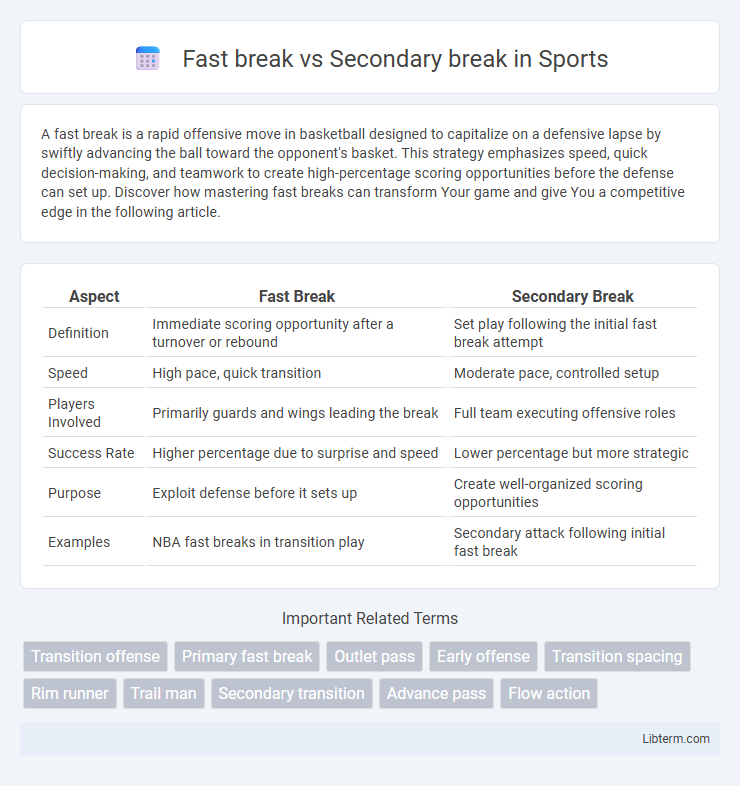A fast break is a rapid offensive move in basketball designed to capitalize on a defensive lapse by swiftly advancing the ball toward the opponent's basket. This strategy emphasizes speed, quick decision-making, and teamwork to create high-percentage scoring opportunities before the defense can set up. Discover how mastering fast breaks can transform Your game and give You a competitive edge in the following article.
Table of Comparison
| Aspect | Fast Break | Secondary Break |
|---|---|---|
| Definition | Immediate scoring opportunity after a turnover or rebound | Set play following the initial fast break attempt |
| Speed | High pace, quick transition | Moderate pace, controlled setup |
| Players Involved | Primarily guards and wings leading the break | Full team executing offensive roles |
| Success Rate | Higher percentage due to surprise and speed | Lower percentage but more strategic |
| Purpose | Exploit defense before it sets up | Create well-organized scoring opportunities |
| Examples | NBA fast breaks in transition play | Secondary attack following initial fast break |
Introduction to Fast Break and Secondary Break
Fast breaks are rapid offensive plays designed to capitalize on a defensive team's transition phase, aiming to score quickly before the opposition sets up its defense. Secondary breaks occur when the initial fast break opportunity is stalled, prompting the offense to reset and utilize structured plays to create scoring chances under more controlled conditions. Understanding the strategic differences between fast break and secondary break is crucial for optimizing team performance in basketball transitions.
Defining the Fast Break in Basketball
The fast break in basketball is an offensive strategy that capitalizes on rapid transitions from defense to attack, aiming to score quickly before the opposing defense can set up. It typically involves pushing the ball up the court with speed, utilizing quick passes and exploiting numerical advantages to create open shots or layups. This contrasts with the secondary break, which refers to an offense that develops after the initial fast break opportunity has been slowed or disrupted, focusing more on structured plays.
Understanding Secondary Break Strategies
Secondary break strategies in basketball refer to the offensive sets organized after the initial fast break opportunity has been exhausted or disrupted. These strategies emphasize motion, spacing, and ball movement to exploit defensive weaknesses, often involving pick-and-roll actions, off-ball screens, and quick passes to create open shots or driving lanes. Understanding secondary breaks requires recognizing defensive alignment shifts and adapting plays to maintain offensive rhythm and maximize scoring efficiency beyond the initial transition phase.
Key Differences Between Fast Break and Secondary Break
Fast break occurs immediately after a defensive rebound or turnover, emphasizing speed and quick outlet passes to score before the opposing defense is set. Secondary break involves more structured offensive sets following the initial fast break opportunity, focusing on strategic ball movement, spacing, and exploiting defensive mismatches. The key difference lies in tempo and organization: fast break prioritizes rapid transition scoring, while secondary break relies on deliberate plays to capitalize on defense adjustments.
Benefits of Implementing Fast Breaks
Fast breaks accelerate offensive play, increasing scoring opportunities while exploiting defensive mismatches before the opposition sets up. Implementing fast breaks enhances team transition speed, improves player conditioning, and puts consistent pressure on opponents, leading to higher game tempo control. This strategy fosters quick decision-making and efficient ball movement, crucial for maximizing scoring efficiency in competitive basketball.
Advantages of Using Secondary Break Offense
Secondary break offense maximizes scoring opportunities by exploiting defensive disarray after the initial fast break, allowing more structured and high-percentage shots. It facilitates better ball movement and spacing, increasing the likelihood of creating open lanes and uncontested perimeter shots. Utilizing secondary breaks reduces turnovers and improves shot selection compared to the often rushed and chaotic fast break scenarios.
Situational Usage: When to Execute Each Break
Fast breaks are most effective immediately after a turnover or defensive rebound, capitalizing on the opposition's unsettled defense to score quickly before they can organize. Secondary breaks occur when the initial fast break is slowed down or stopped, focusing on exploiting mismatches and creating high-percentage scoring opportunities through controlled ball movement and set plays. Coaches prioritize fast breaks in transition scenarios for quick points and secondary breaks during half-court sets to maintain offensive rhythm and exploit defensive lapses.
Core Skills Required for Effective Breaks
Effective fast breaks require speed, precise passing, and quick decision-making to capitalize on defensive disorganization. Core skills for secondary breaks emphasize court vision, strategic spacing, and patience to exploit set defensive weaknesses. Mastery of ball handling, timing, and communication is essential for both break types to maintain offensive momentum.
Common Mistakes in Fast and Secondary Breaks
Common mistakes in fast breaks include poor spacing and lack of communication, leading to clogged lanes and missed scoring opportunities. In secondary breaks, players often fail to read defensive rotations correctly, causing delayed ball movement and contested shots. Both breaks suffer from overdribbling and hesitation, which allow defenses to reset and reduce offensive efficiency.
Integrating Breaks into Team Offense Systems
Integrating fast breaks and secondary breaks into team offense systems enhances scoring opportunities by exploiting transition speed and organized positioning, respectively. Fast breaks capitalize on immediate numerical advantages before the defense sets up, while secondary breaks involve structured movement to create open shots after initial transition actions. Effective synchronization of these breaks within offensive schemes requires precise timing, player roles, and decision-making to maximize efficiency and maintain floor spacing.
Fast break Infographic

 libterm.com
libterm.com